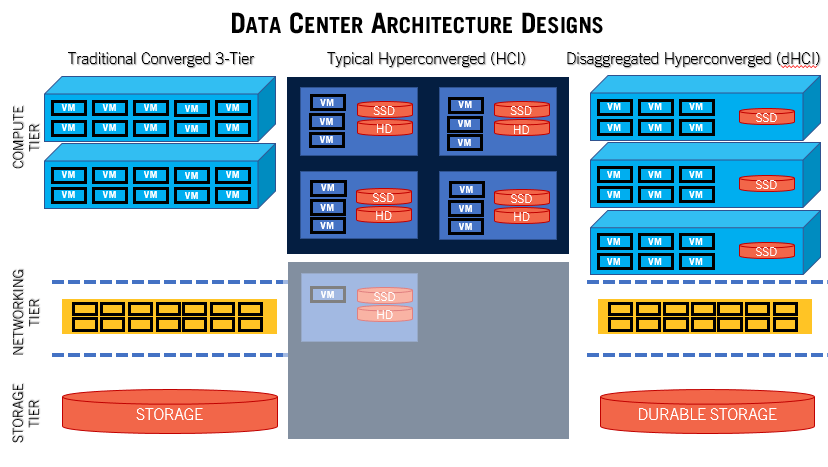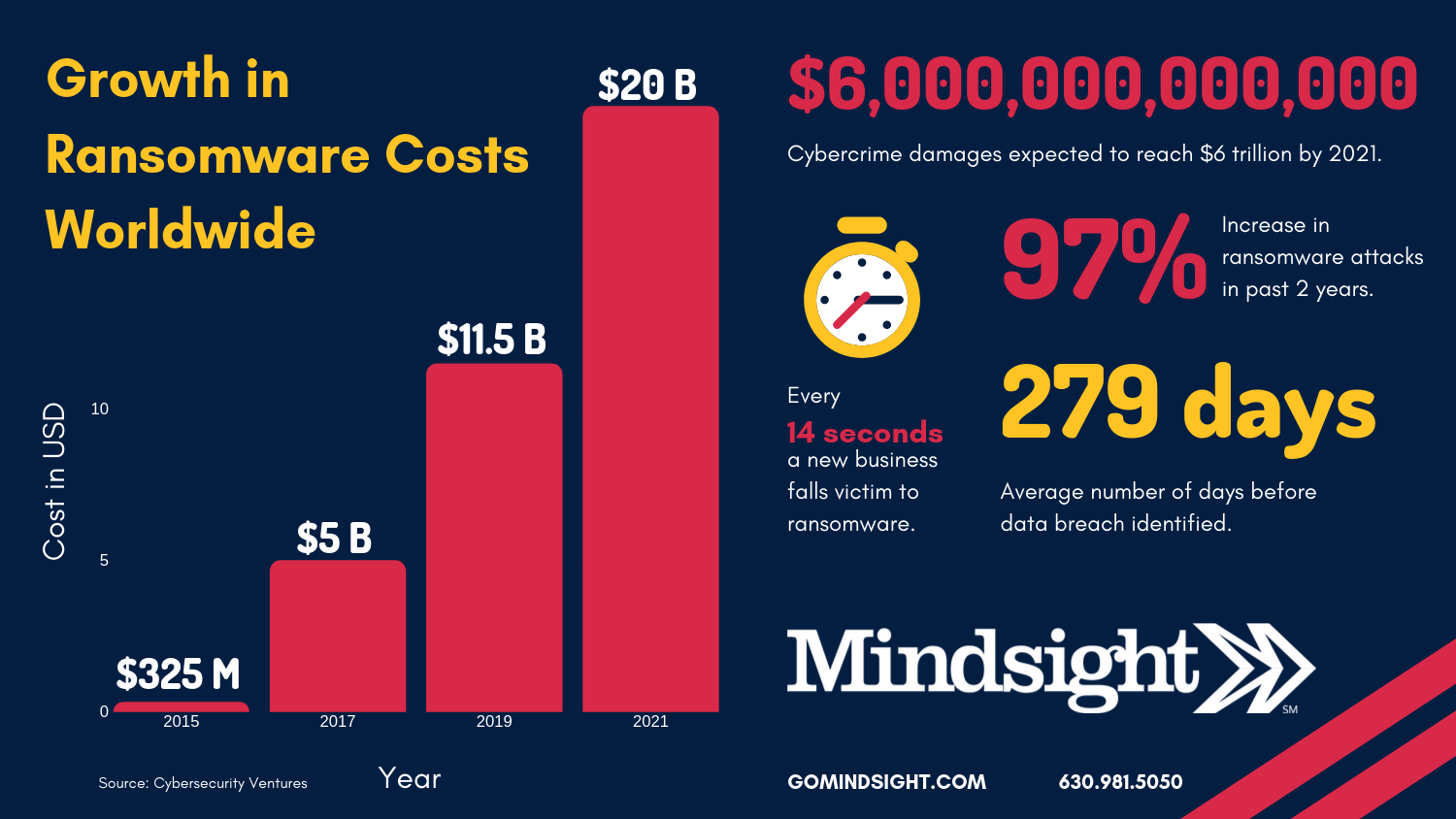December 19, 2019 by Siobhan Climer and Eric White
The next evolutionary step in data center architecture arrived quietly back in 2012. A small group of former Data Domain and VMware engineers joined together to found Datrium. Their mission? “Liberation from complexity” through technology – specifically via disaggregated hyperconverged infrastructure (dHCI).
While the ramp-up to dHCI has been slow, the industry is finally taking note. This summer, analysts dove deep into this latest data center architecture that combines the simplicity of hyperconverged infrastructure (HCI) with the reliability and familiarity of converged infrastructure (CI).
Data Center Architecture Evolution
While we could start back with mainframes and minicomputers, today’s data center architecture types (see Figure 1) fall along a three-step evolutionary process, from the traditional converged three-tier architecture through to HCI and, now, dHCI.
Figure 1: Data Center Architecture Designs
In traditional converged infrastructure (CI), there are three tiers within the architecture – compute, networking, and storage. CI has been the standard for centralized management of IT resources and consolidated systems for some time. Putting storage in a separate tier makes moving workloads easy, and SANs offers improved resiliency and redundancy.
The challenge with CI is that separate tiers means increased latency. To get data, you have to move through the server tier, network tier, and then back again.
 HCI attempted to consolidate this architecture to improve performance and resiliency. While HCI does offer these benefits, there are also drawbacks. For one, the model requires a linear growth model as you cannot buy more compute or storage independently – not ideal for companies that value scalability.
HCI attempted to consolidate this architecture to improve performance and resiliency. While HCI does offer these benefits, there are also drawbacks. For one, the model requires a linear growth model as you cannot buy more compute or storage independently – not ideal for companies that value scalability.
While there are use cases for both CI and HCI, the opportunity for an advanced data center architecture that combines the best of both systems to create something new left an opening for the development of dHCI.
dHCI is the combination of these two designs. By disaggregating the components, dHCI improves performance, lowers latency, and drives scalability through independent compute and storage growth.
Industry Takes Note Of dHCI
Just this September, Gartner published research on how infrastructure and operations (I&O) leaders should leverage dHCI solutions to optimize infrastructure deployment.
IDC recently added dHCI as a subcategory of HCI and is tracking it as part of its worldwide converged systems tracker. Others are debating the differences between dHCI and its predecessors and whether Datrium, HPE Nimble, Nutanix, Dell EMC, VMware, or Cisco will take over the market for dHCI solutions.
Why 2020 Will Be The Year Of dHCI
While the ramp-up to dHCI has been slow, things are changing. The subdivision of dHCI from the hyperconverged infrastructure market segment indicates a growing understanding of the functional differences between a typical HCI solution and dHCI.
 One of the key differentiators between HCI and dHCI is the embedded disaster recovery as a service (DRaaS) functionalities. Some dHCI vendors, like Datrium, integrate DRaaS into the management of the architecture. Datrium’s dHCI solution – DVX – works with the complete Datrium product line to meet multiple DR responsibilities:
One of the key differentiators between HCI and dHCI is the embedded disaster recovery as a service (DRaaS) functionalities. Some dHCI vendors, like Datrium, integrate DRaaS into the management of the architecture. Datrium’s dHCI solution – DVX – works with the complete Datrium product line to meet multiple DR responsibilities:
- Service contracts and billing, including AWS, VMware Cloud accounts
- Single point of support for whole stack
- Managing DR orchestration uptime and compliance
- Backup vaulting as a service (Datrium Cloud DVX on S3)
- Automating user-defined DR plans
- Terms of Service for backup and DR plan execution

That leaves the client to create a DR plan, identify the right plan for SLA needs, and activate the DR service during a disaster. By simplifying disaster recovery, dHCI architecture, such as Datrium’s solution, simplify DR.
Why is that so important? Disaster recovery planning is essential in the context of the rise in risk businesses face. From unwieldy weather systems to dramatic increases in ransomware attacks, disaster recovery programming is vital for organizations today.
Figure 2: Global Rise In Ransomware
By 2021, ransomware costs are expected to reach $20 billion worldwide. To ensure continuity despite the risk, businesses are seeking improved disaster recovery solutions that preempt risk.
dHCI provides a potential solution. By integrating disaster recovery into the modernization of the data center, organizations will dislodge traditional silos around data center architecture to reduce risk and grow.
There’s more to learn. Talk with one of our experts today about how dHCI is different and what steps you can take to modernize your architecture. Sign up for our one-on-one virtual or in-person whiteboard session. Talk with our engineers to learn how dHCI can work for you.
Like what you read?
Contact us today to discuss data center infrastructure.
About Mindsight
Mindsight, a Chicago IT services provider, is an extension of your team. Our culture is built on transparency and trust, and our team is made up of extraordinary people – the kinds of people you would hire. We have one of the largest expert-level engineering teams delivering the full spectrum of IT services and solutions, from cloud to infrastructure, collaboration to contact center. Our customers rely on our thought leadership, responsiveness, and dedication to solving their toughest technology challenges.
Contact us at GoMindsight.com.
About The Authors
Eric White is a Senior Solutions Architect at Mindsight, an IT Services and Consulting firm located in the Chicago area. With over ten years of experience in information technology and leadership, Eric excels at implementing network and data center technologies, designing high-yield solutions for the business. Holding professional certifications from Microsoft, VMware, and EMC, as well as the Cisco CCNP certification, Eric is an expert at solving business realities with a client-centric focus that delivers.
Siobhan Climer, Science and Technology Writer for Mindsight, writes about technology trends in education, healthcare, and business. She writes extensively about cybersecurity, disaster recovery, cloud services, backups, data storage, network infrastructure, and the contact center. When she’s not writing tech, she’s reading and writing fantasy, gardening, and exploring the world with her twin daughters. Find her on twitter @techtalksio.
5 Benefits of Hyperconvergence (HCI): An Infrastructure Report




